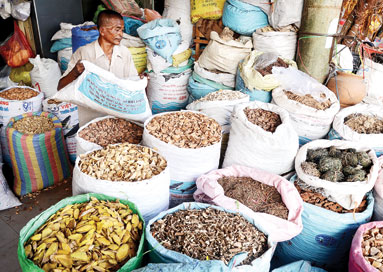 |
| A vendor of traditional medicine at Phnom Penh’s Orussey market tends his wares. (Photo by: Pha Lina) |
Wednesday, 28 December 2011
Roth Meas
The Phnom Penh Post
While modern science has found ways to cure and treat a host of diseases, many people have not given up on traditional medicine. In Cambodia, traditional medicines are available across the country, prescribed by practitioners of traditional medicine known as krou khmer.
Roeung Serey Sokun, who owns traditional clinic Phka Chhouk in Phnom Penh, learned traditional medication from his father in the 1970s, and in 1981 he began his own career specialising in healing broken bones.
“Many trees in Cambodia contain substances to treat diseases. Some trees grow in the deep forest, near lakes or next to our house. Some medicine we eat almost every day, but we don’t know them. For instance, banana can cue our stomach, carrots can cue our veins, guavas can heal diarrhoea. Some scientific pills are derived from these trees too,” Sokun says.
But not all parts of trees are right for medicine. Sometimes only the roots, bulbs, bark, leaves or flowers can be used for medicine. krou khmer will take the part they need and dry the roots, bark, flowers or leaves and dry them under the sun. Often, they will boil them in water or soak them in rice spirit.
“If people can, they will soak it [the substance] in rice spirit. If they can’t, they can boil them with normal water to drink. If they can boil in the clay pot, that will be more efficient. They can also use scientific pills together with traditional medicine, except with herbs because that can be poisonous,” he says.
For mending broken bones, Sokun uses a different way from a modern doctor. He just bandages the injured area and feeds his patients traditional medicines. He has treated hundreds of patients. People come to his clinic every day. He claims that most of his patients with broken bones can recover in three months.
Orussey Market is the place to buy all kinds of traditional medicine in Phnom Penh. Products used in traditional medicine are brought from rural districts across the Kingdom Cambodia.
Vong La, 52, a villager from Koh Dach village, Kandal province, makes the trip to the capital to buy traditional medicine to relieve her sore muscles regularly.
“Actually, I didn’t do any hard work, but my body still got sore. Villagers told me to come here. I just told the healers my symptoms and they chose some pieces tree trunk and told me to soak it in rice spirit to drink. Now I never feel sore anymore,” Vong La says.
Although she feels comfortable with traditional medicine, Vong La has not given up on Western scientific medicine. She sometimes takes them together and both of them are efficient for her.
One traditional doctor, Ly Bunnarith, who promotes his traditional medicine clinic in the media claims that traditional medicine can cure many kinds of disease, but not HIV.
Concerned about an increase in advertising touting the curative power of traditional medicines – including dubious claims about such diseases as HIV/AIDS and cancer – the Ministry of Health has warned practitioners of traditional Cambodian medicine to obey the law or face a crackdown.
“It is the opinion of the health minister and health officials at all levels that controlling the use of traditional medicine in the Kingdom is a top priority for the Ministry of Health,” under-secretary of state Yim Yan told the Post in November.
Hieng Punley, director general of the department of traditional medicine, says that the Ministry even established school of traditional medicine recently and has called on all traditional healers to get more training.

No comments:
Post a Comment